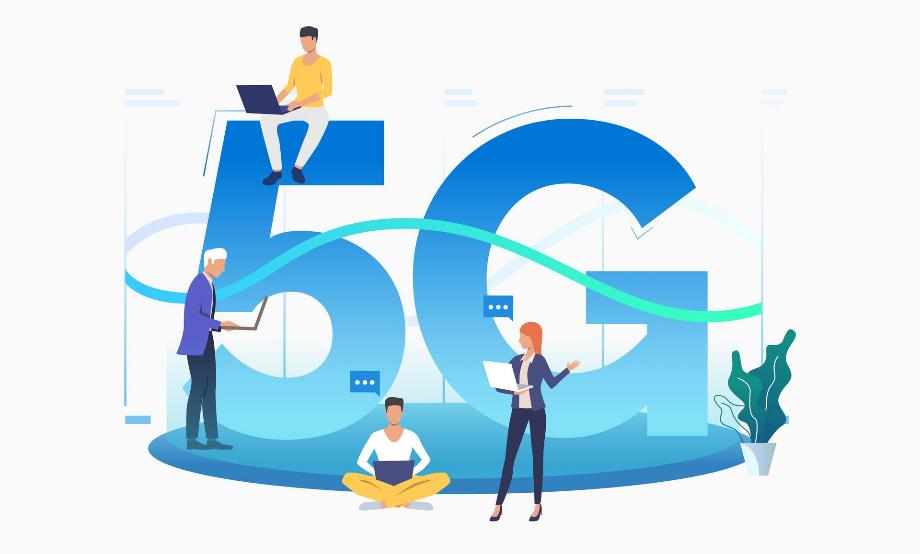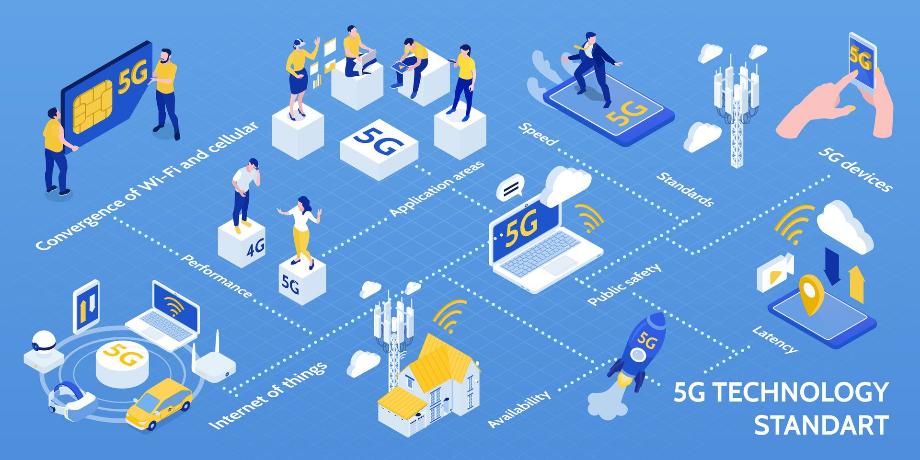Als 5G wird das Netz der fünften Mobilfunkgeneration bezeichnet. Der Nachfolger von LTE (4G) und UMTS (3G) soll neuer Standard werden und zielt auf höhere Datenraten, verbesserte Kapazität und ein intelligentes Netz ab.
Bedeutende Unterschiede zu den Vorgängern sind steigende Übertragungsgeschwindigkeiten bei sinkenden Kosten und niedrigem Energieverbrauch, kaum spürbare Latenzzeiten - also Reaktionsgeschwindigkeiten - und eine höhere Variabilität, was bedeutet, dass das Netz die Anforderungen ermitteln und seine Leistung dementsprechend anpassen kann.
Konkret gesagt ist mit 5G eine Datenrate von bis zu 10 Gigabit pro Sekunde sowie eine Latenzzeit von unter 1 Millisekunde möglich. Dies bedeutet eine bis zu zehnfach höhere Datenübertragung als bei dem 4G-Netz. Diese Verbesserungen kommen durch neuartige Übertragungstechniken auf der Luftschnittstelle und durch erhöhte Funkfrequenzbereiche zustande. Eingesetzt wird 5G wie bereits 3G und 4G bei 2 Gigahertz und zusätzlich bei 3,4 bis 3,7 Gigahertz mit kürzeren Wellen. Somit können mehr Information in geringerer Zeit übertragen werden, allerdings bedeutet dies eine geringere Reichweite, weshalb deutlich mehr Funkmasten notwendig sind.

Mit seiner enorm hohen Geschwindigkeit und Netzkapazität gilt das 5G-Netz als Treiber der Digitalisierung. Eine daraus folgende neue Dimension der Vernetzung und Kommunikation in Echtzeit verändert nahezu alle Lebensbereiche unserer Gesellschaft. Der neue Mobilfunkstandard sorgt für schnelleres und zuverlässiges (mobiles) Internet, was nicht nur für mobiles Gaming und Streaming und Großveranstaltungen von Wichtigkeit ist, sondern bedeutet auch eine wachsende Anzahl vernetzter Alltagsgegenstände. Ob Smart Mobility oder Smart Metering und Smart Home - so ziemlich alle Smart City Konzepte, welche bereits in unserem Blog thematisiert wurden, werden realisierbarer.
Vor allem aber werden Wirtschaft und Industrie enorm von der neuen Mobilfunkgeneration durch eine Effizienzsteigerung und zugleich Kostensenkung profitieren. Die Entwicklung der sogenannten Industrie 4.0 erhält mit den schnellen Übertragungsraten einen maßgeblichen Aufschwung. Zu nennen sind hier besonders neue Möglichkeiten der Vernetzung und Zusammenarbeit sowie die Revolutionierung von Anlagensteuerung mittels Maschine-zu-Maschine-Kommunikation.
Als Nachteil angesehen werden kann der anfallende Zeit- und Kostenaufwand. Aufgrund der hohen Frequenzen, die genutzt werden, muss für eine flächendeckende Installation des 5G-Netzwerkes die Menge der Sendemasten steigen - die Kosten, sowohl für Errichtung, Inbetriebnahme und Wartung, werden voraussichtlich höher sein als für 4G-Netze. Mit dem teuren und langwierigen Ausbau des 5G-Netzes ist es allerdings noch nicht getan, notwendig für die Nutzung sind ebenso neue Endgeräte mit einem entsprechenden Chip.
Auch wachsen mit der Debatte um das 5G-Netz die Sorgen hinsichtlich Gesundheit und Sicherheit. Festzuhalten ist, dass sich mit 5G wenig an der Strahlenbelastung ändert, da die genutzten Funkfrequenzen größtenteils dieselben sind wie für 4G und auch schon bereits für andere Zwecke genutzt werden. Die Strahlungsleistung wird von der zuständigen Bundesnetzagentur überwacht, gemessen und dokumentiert. Empfehlungen hinsichtlich der Nutzung des Handys hat das Bundesamt für Strahlenschutz auf seiner Website veröffentlicht. Hinsichtlich der Frage, wie sicher das 5G-Netz ist, lässt sich nicht verleugnen, dass mit einer steigenden Anzahl an vernetzten Geräten auch mehr Einfallstore für Cyber-Kriminelle entstehen. Da allerdings mit der Installation eines 5G-Netzwerks verschiedene Sicherheitsvorkehrungen geprüft und grundlegend verbessert werden, kann ein deutlich zuverlässigeres und belastbareres Netz aufgebaut werden.

Doch wann können Verbraucher mit dem vielversprechenden Netz rechnen?
Am 12.Juni 2019 endete nach mehr als zwölf Wochen die Auktion von 5G-Mobilfunkfrequenzen. Sowohl die deutsche Telekom als auch Vodafone, Telefónica und 1&1 Drillisch (Unternehmen United Internet mit GMX und Web.de) sicherten sich diese 41 Frequenzblöcke und zahlten insgesamt eine Summe von 6.549.651.000 Euro. Am meisten Geld investierte die Deutsche Telekom mit rund 2,2 Milliarden Euro. Danach folgten Vodafone mit 1,9 Milliarden Euro, Telefónica mit 1,4 Milliarden Euro und 1&1 Drillisch mit rund einer Milliarde Euro. Somit wird es in Deutschland künftig Funkmasten von vier anstatt bisher drei Unternehmen geben. Zugeteilt sind die Frequenzen bis 2040, danach können sie neu versteigert werden.
Angeboten wird 5G in wenigen Standorten Deutschlands bereits seit Juli 2019, bis Ende 2022 soll laut den Telekommunikationsanbietern 5G dem Großteil Deutschlands angeboten werden. Am weitesten mit der Entwicklung ihrer Netze sind aktuell die Deutsche Telekom und Vodafone. Die Deutsche Telekom hat angekündigt, dass sie bis Ende 2025 sogar mindestens 99 Prozent der deutschen Bevölkerung mit 5G versorgen wolle.
Da mit dem Netzaufbau allerdings enorme Kosten und umfassende Genehmigungsverfahren einhergehen, wird dies wohl noch etwas dauern. Bereits früher können Ballungsgebiete mit Teilnetzen rechnen.
Wie lange der Ausbau der Technik tatsächlich dauern wird und wie viele Milliarden dabei verschlungen werden, kann und will keiner festlegen. Fest steht: es ist ein internationales Wettrennen um die Technik entfacht und vor allem China, Südkorea, Japan und die USA haben 5G zu einer zentralen Zukunfts-Technologie erklärt. Auch die deutsche Bundesregierung teilte mit, zum Leitmarkt für 5G werden zu wollen. Ob und wie dies gelingt, bleibt abzuwarten.
Quellen: www.bsi.bund.de, www.verbraucherzentrale.de, www.handelsblatt.de
Nächstes Netz: 5G